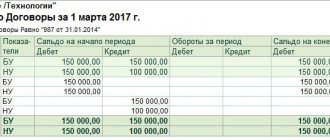How to calculate VAT from the amount
How to calculate VAT on the amount? It's not difficult: you just need to mathematically calculate the percentage. The calculation is made using the formula:
VAT = NB × Nst / 100,
Where: NB - tax base (that is, the amount without VAT), Nst - VAT rate: 20 percent (until 01/01/2019 - 18) or 10 percent.
ConsultantPlus experts provided examples of VAT calculations for sellers. Get free trial access to the system and proceed to calculations.
Total amount
The amount of VAT payable to the state treasury is calculated using the following formula:
VAT payable = Accrued VAT – VAT accepted for deduction
If the calculation results in a value equal to zero, then the organization is exempt from paying to the state treasury. In situations where VAT turns out to be negative, you can count on reimbursement of value added tax from the state budget.
General rules for calculating VAT amount
How to calculate VAT including
Calculating VAT as well means highlighting the tax that is included in the final amount. Here the formulas are used for calculation:
VAT = C / 120 × 20 - if you need to calculate VAT 20% (from 01/01/2019),
VAT = C / 118 × 18 - if you need to calculate VAT 18% (until 01/01/2019),
VAT = C / 110 × 10 - if the tax rate is 10%,
Where: C is the amount including VAT.
See also “ What is included in the list of goods subject to VAT at a rate of 10%? »
ATTENTION! This calculation does not mean applying estimated rates of 20/120 (18/118) or 10/110 - it is simply a way to separate the tax from the total.
Read more about settlement rates in this article .
Calculation of VAT payable to the budget: example
VAT payable to the budget is calculated based on the results of each period. In some cases, it is possible for the state to reimburse the obligation if, at the end of the period, the amount of deductions is greater than the amount of the contribution. To calculate the amount of VAT, you will need to submit a declaration of deductions, a copy of the contract, as well as statements confirming the movement of funds, copies of invoices, etc.
You can consider an example of how the calculation algorithm is determined. For example, LLC revenue for the second quarter amounted to 300 and 500 thousand (a rate of 10 and 20% was applied). To establish the payment amount you need:
- Determine the amount of payment based on the results of the sale – (300,00010%)/100 + (500,00020%)/100 = 30,000 + 100,000=130,000.
- Establish the amount that the organization contributed as part of the price for the products and which is subject to deduction - 200,000 (the amount of purchase of products taxed at a rate of 10%, the fee is already included in the price) * 10% + 250,000 (the cost of paid goods taxed at a rate of 20 %) * 20% = 20,000 + 50,000 = 70,000.
- We calculate the indicator for transfer to the budget – 130,000 – 70,000 = 60,000.
Reporting is submitted quarterly, in accordance with the Tax Code of the Russian Federation. The formulas for determining deductions are not complicated. The contribution amount is the cost of products and services including excise taxes, but without tax, multiplied by the rate. In total, several types of rates are used - 0 and 10% - preferential, as well as the main rate - 20%.
To establish the accrued payment, it is necessary to add the collection from goods sold with deductions from the prepayment. To calculate the contribution deduction, add:
- A payment made to a payer when purchasing products or services.
- Tax imposed upon transfer of prepayment.
- A fee paid at customs upon import.
- A contribution calculated by the seller from an advance payment at the time of shipment of products.
- Fee paid as an agent.
The total amount to be paid to the budget will be equal to the accrued payment minus the deduction.
Example of VAT calculation
Using the above formulas, we will analyze how to correctly calculate VAT (in excess of the amount, including), using examples.
Example 1
LLC "X" sells a batch of concrete blocks in the amount of 100 thousand pieces. at a price of 55 rub. a piece. The VAT rate is 20% (clause 3 of Article 164 of the Tax Code of the Russian Federation), tax is not included in the price. How to calculate VAT 20% and the final cost of the shipment including tax?
- First, we determine the cost of the batch without VAT (tax base):
55 rub. × 100,000 pcs. = 5,500,000 rub.
- Let's calculate VAT from the amount:
5,500,000 × 20/100 = 1,100,000 rub.
- Let's calculate the amount including VAT:
5,500,000 + 1,100,000 = 6,600,000 rub.
- Or you can determine the total amount immediately, without first calculating the tax:
5,500,000 × 1.20 = 6,600,000 rub.
Accordingly, the following must be indicated in settlement documents and invoices:
- cost without VAT - 5,500,000 rubles,
- VAT 20% - RUB 1,100,000,
- total including VAT - 6,600,000 rubles.
Example 2
According to the price list of X LLC, the price of a curbstone including VAT is 240 rubles. for 1 piece The buyer ordered a batch of 10 thousand pieces. Let's calculate VAT 20%.
- First, let's determine the final cost of the batch:
240 rub. × 10,000 pcs. = 2,400,000 rub.
- We will calculate VAT including:
2,400,000 / 120 × 20 = 400,000 rub.
- The amount remaining excluding VAT:
2,400,000 – 400,000 = 2,000,000 rub.
It can also be found without prior allocation of tax:
2,400,000 / 1.20 = 2,000,000 rub.
You can check the correctness of the calculation by charging VAT on the received value without tax:
2,000,000 × 20/100 = 400,000 rub.
Accordingly, the following must be indicated in settlement documents and invoices:
- cost without VAT - 2,000,000 rubles,
- VAT 20% - 400,000 rubles,
- total including VAT - 2,400,000 rubles.
For information on how to reflect the calculated VAT amount in the VAT return and in accounting, see the Ready-made solution from ConsultantPlus. Get trial access to K+ for free.
Determination of the tax base
Perhaps we should start with the basics: the tax base in accordance with paragraph 1 of Art. 53 of the Tax Code of the Russian Federation refers to the cost, physical or other characteristics of the object of taxation , which for the purposes of VAT is the transfer of ownership of goods, or the transfer of the results of work, or the provision of services on a paid and free basis in the territory of the Russian Federation ( clause 1 of Article 146 of the Tax Code of the Russian Federation ). Since we are talking about a cost characteristic, in most cases the tax is calculated based on the cost of those goods (works, services) that are sold (transferred). When determining the tax base, revenue received from the sale of goods (work, services) is determined based on all income of the taxpayer associated with payments for the specified goods (work, services), received by him both in cash and in kind, including payment securities ( clause 2 of Article 153 of the Tax Code of the Russian Federation ) in total for all types of transactions taxed at the same tax rate ( clause 1 of Article 153 of the Tax Code of the Russian Federation ).









